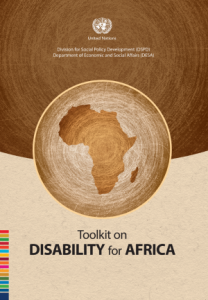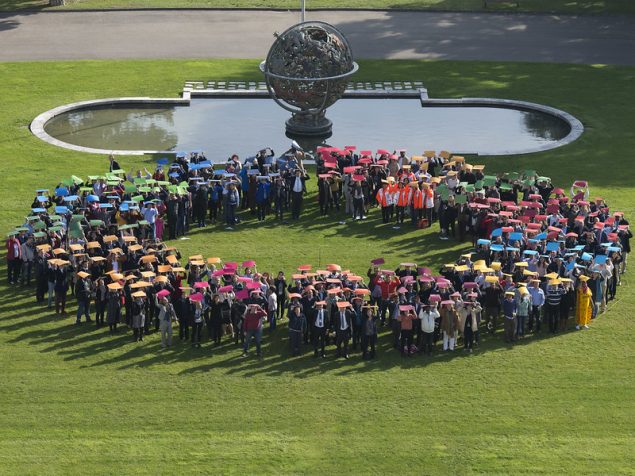Key links:
- NEW: Follow-up to the Habitat III – disability in urban development: Cities 2030 – Cities for All: Implementing the New Urban Agenda
- Outcome document of the United Nations Conference on Housing and Sustainable Urban Development (Habitat III): New Urban Agenda
- UN DESA/DSPD – Ecuador High-Level Forum on Disability Inclusion and Accessible Urban Development, 16 October 2016, Quito, Ecuador.
- Good Practices of Accessible Urban Development (Word Version, 65MB; PDF Version, 3MB)
- Info-graphic on Disability and Accessible Urban Development
- HABITAT III: Revised Zero Draft of the New Urban Agenda – 10 September 2016
- UN Habitat III website
- Forum on Ways forward Towards a Disability Inclusive and Accessible New Urban Agenda (New York, 14 June, 2016) [Flyer] [Concept note] [Programme] [CART Transcripts]
- Briefing Note on Disability and Sustainable Urban Development
- Urban Dialogue on the Zero Draft of the New Urban Agenda
- Accessible urban development includes everyone
- Key milestones leading to the UN Habitat III (Updated on 12 May, 2016)
- Issue paper: Accessibility and Disability Inclusion in Urban Development
- The Right to Adequate Housing for Persons with Disabilities Living in Cities, UN Habitat
- DESA/DSPD Forum on Disability Inclusion and Accessible Urban Development (Nairobi, 28-30 October 2015)
- DESA/DSPD Forum on Accessible and Inclusive Urban Development (11 June 2015) Summary Report of Forum
Introduction
It is estimated that by 2050, 66% of the world’s population will be living in cities. The United Nations’ Third Global Conference on Housing and Sustainable Development – Habitat III – will take place in 2016 to review the progress, experience and less ons learnt in the past and to design a “New Urban Agenda”. This Agenda of focused policies and strategies is hoped to harness the power and forces behind urbanization. Habitat III therefore provides an important platform for the world’s urban development policy makers and practitioners, as well as those working in the field of disability to review current progress and practices and consider opportunities for change.
ons learnt in the past and to design a “New Urban Agenda”. This Agenda of focused policies and strategies is hoped to harness the power and forces behind urbanization. Habitat III therefore provides an important platform for the world’s urban development policy makers and practitioners, as well as those working in the field of disability to review current progress and practices and consider opportunities for change.
Importantly, the New Urban Agenda needs to ensure that future cities, towns and basic urban infrastructures and services are more environmentally accessible, user-friendly and inclusive of all people’s needs, including persons with disabilities.
Accessibility and disability inclusion in the contexts of urban development
Urban environments, infrastructures, facilities and services can impede or enable, perpetuating exclusion or fostering participation and inclusion of all members of society. Persons with disabilities face widespread lack of accessibility to built environments, from roads and housing, to public buildings and spaces, basic urban services such as sanitation and water, health, education, transportation, and emergency response programmes. Barriers to information and communications, including relevant technologies and cultural attitudes including negative stereotyping and stigma also contribute to the exclusion and marginalisation of persons with disabilities in urban environments.
Too often, urban environments have served as a barrier to the inclusion and participation of persons with disabilities in economic and social development in cities and communities. Lack of accessibility contributes greatly to the disadvantaged and vulnerable situations faced by persons with disabilities, leading to disproportionate rates of poverty, deprivation and exclusion among persons with disabilities.
It is important to note that developing urban infrastructures, facilities and services that are designed and built following accessibility or inclusive “universal design” principles from initial stages of planning and design incurs additional costs equalling to approximately less than 1 per cent of the total cost . The returns, of course, lead to many more benefits to all service users (such as fewer accidents, more diversity of society capturing persons of all talents and abilities).
International normative frameworks
Accessibility is established in the Convention as a cross-cutting factor that enables persons with disabilities to live independently and participate fully in all aspects of life. The Preamble to the Convention emphasizes the “importance of mainstreaming disability issues as an integral part of relevant strategies of sustainable development.” Accessibility is a general principle (Art. 3) of the Convention and is notably included as a general obligation of States Parties (Art. 4) to proactively promote accessibility in design and development as well as availability of new technologies, including those of information and communication technologies (ICTs). Yet, there remains a gap between the ambitions of the Convention and mainstream socio-economic development policy and practices on the ground. During the 2013 World Habitat Day, UN Secretary-General Ban Ki-moon called on the international community to make towns and cities accessible for all persons in society, ensuring inclusive development and participation.
As the world is now designing a post-2015 development agenda, the global community is presented with an opportunity to promote accessibility and inclusion of persons with disabilities in the “New Urban Agenda” as a precondition for inclusive, sustainable and equitable development.
The Work of the United Nations
The work of the United Nations in promoting accessibility and advancement of persons with disabilities is deeply rooted in its Charter and commitment to promoting economic and social progress and human rights for all.
The United Nations system is taking concrete steps to make the UN environment more inclusive of and accessible to persons with disabilities. Accessibility is also a key goal and means for successful implementation of the Strategy and Plan of Action of the United Nations Inter-Agency Support Group for the Convention on the Rights of Persons with Disabilities (IASG), now composed of over 25 UN agencies.
The Department of Economic and Social Affairs (DESA), as the UN disability focal point has been actively promoted accessibility in context of sustainable and inclusive development for all. DESA organised experts group meetings on accessibility especially on built environments (Washington DC, 2010) and on information and communication and ICTs including in the situations of disaster risk (Tokyo, 2012) and published analytical researches on accessibility and development facilitating and supporting intergovernmental processes and bodies. DESA, serving as the co-chair of the UN IASG group and the Inter-Departmental Task Force on Accessibility at the United Nations Headquarters, has been also actively in promoting accessibility and disability inclusion within the work of the UN.
Moving forward
In July 2016, the Third Global Conference on Housing and Sustainable Development (Habitat III) will take place in Quito to review the progress, experience and lessons learnt in the past and to design a “New Urban Agenda” , focused on policies and strategies that can result in effectively harnessing the power and forces behind urbanization.
The envisaged New Urban Agenda will provide the global framework for urbanisation for the next decade. It therefore presents an opportunity for the international community to consider the place of accessibility and disability inclusion in economic and social urban development. A New Urban Agenda, if well-planned, can be inclusive of and accessible to all, and could set the stage for future rapid urbanization to be used as an opportunity to create an enabling and transformative environment for production capacities, inclusion and better lives for all , by including and engaging all persons in society.
Other resources
- What are cities’ next steps toward implementation?
- Issue paper: Accessibility and Disability Inclusion in Urban Development
- Letter from the SG of the Habitat III Conference to Stakeholders
- Outcome document of the high-level meeting of the General Assembly on the
realization of the Millennium Development Goals and other internationally agreed
development goals for persons with disabilities: The way forward, a disability-inclusive development agenda towards 2015 and beyond (General Assembly resolution A/RES/68/3) - Report of the Open Working Group of the General Assembly on Sustainable Development Goals (A/68/970)
- Accessibility and Development (UNDESA publication ST/ESA/350)
- UNDESA Forum on Development and Disability (New York, July 2013)
- Third UN Conference on Housing and Sustainable Urban development (Habitat III: to
be held in 2016)- Read more about the relevant processes and the work of the Preparatory Committee for the Habitat III
- Making Cities Resilient (UNISDR)
- World Habitat Day (observed each year on the first Monday of October)
- World Cities Day (celebrated on 31 October 2014)
- State of the World’s Cities (UNHABITAT, 2012)
- Modelo Para Disenar Espacios Accesibles. Espectro Cognitivo (La Ciudad accesible 2014)
- Design for All Foundation




